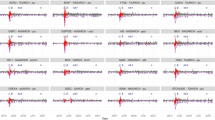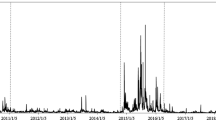Abstract
Volatility is an important feature of e-commerce activities, and overnight information has the greatest impact on the market volatility of e-commerce. The identification of contemporaneous jumps (cojumps) is crucial to studying the effect of overnight information on market volatility. This paper takes stock and futures e-commerce as the research object, based on the heterogeneous autoregression model of the Realized Volatility under high-frequency data, not only the characteristics of cojumps between the CSI 300 stock index and the future index are investigated, but also the effects of overnight factors on the future volatility. The results indicate that the Extended-Weighted Realized Volatility (EWRV) modifying both the intraday and overnight effects may be a better estimator of volatility. The joint BW test could be more efficient in the identification of cojumps with significant overnight characteristics. The effect of the overnight cojumps on the future volatility is significantly positive and greater than that of the intraday cojumps. In the Electronic Commerce stock index market, there is not enough evidence of the transmission from the overnight cojumps to the intraday volatility, which means the future index market may have no significant spillover to the stock index market.



Similar content being viewed by others
References
Barndorff-Nielsen, O., & Shephard, N. (2004). Power and bipower variation with stochastic volatility and jumps. Journal of Financial Econometrics, 2, 1–37.
Gilder, D., Shackleton, M. B., & Taylor, S. J. (2013). Cojumps in stocks prices: Empirical evidence. Journal of Banking & Finance, 40, 443–459.
Wang, H., Yue, M., & Zhao, H. (2015). Cojumps in China’s spot and stock index futures markets. Pacific-Basin Finance Journal, 35, 541–557.
Tang, Y., & Lin, X. (2015). Consider the fluctuation modeling of common jumps: Based on the high-frequency data perspective. China Management Science, 23(08), 46–53.
Qu, H., & Ji, P. (2016). Covariance prediction-based on the multivariate HAR model. Management Science, 29(6), 28–38.
Ma, F., Wei, Y., & Huang, D. (2016). Can overnight returns improve the predictive capabilities of high-frequency volatility models. Systems Engineering Journal, 31(06), 783–797.
Song, Y., & Wang, X. (2017). Does overnight information affect the volatility model capability. Financial Issues Studies, 02, 59–65.
Bollerslev, T., Law, T. H., & Tauchen, G. (2008). Risk, jumps, and diversification. Journal of Econometrics, 144(1), 234–256.
Lahaye, J., Laurent, S., & Neely, C. J. (2011). Jumps, cojumps and macro announcements. Journal of Applied Econometrics, 26(6), 893–921.
Andersen, T. G., Bollerslev, T., Frederiksen, P., et al. (2010). Continuous-time models, realized volatiliti-es, and identificationable distributional implications for intraday stock returns. Journal of Applied Econometrics, 25(2), 233–261.
Bollerslev, T., Todorov, V., & Sophia, Z. L. (2013). Jump tails, extreme dependencies, and the distribution of stock returns. Journal of Econometrica, 172(2), 307–324.
Andersen, T. G., Bollerslev, T. M., & Diebold, F. X. (2001). The distribution of realized stock return volatility. Journal of Financial Economics, 61, 43–76.
Andersen, T. G., Bollerslev, T. M., & Diebold, F. X. (2003). Modelling and forecasting realized volatility. Econometrica, 71(2), 579–625.
Guo, M., & Zhang, S. (2006). VaR computation based on “implemented” volatility and its persistence study. Journal of Northwest A & Forestry University (Social Sciences), 06, 42–45.
Li, L., & Guo, M. (2009). Comparative study of volatility and empowerment achieved. Journal of Northwest A & Forestry University (Social Sciences), 9(02), 44–47.
Hansen, P. R., & Lunde, A. (2005). A realized variance for the whole day based on intermittent high-frequency data. Social Science Electronic Publishing, 3(4), 525–554.
Bajgrowicz, P., Scaillet, O., & Treccani, A. (2015). Jumps in high-frequency data: Spurious detections, dynamics, and news. Management Science.
de Pooter, M., Martens, M., & van Dijk, D. (2008). Predicting the intraday covariance matrix for S&P 100 stocks using intraday data—but which frequency to use? Econometric Reviews, 27(1–3).
Barndorff-Nielsen, O., & Shephard, N. (2006). Economics of Identificationing for jumps in financial economics using bipower variation. Journal of Financial Econometrics, 4, 1–30.
Aït-Sahalia, Y., & Xiu, D. (2016). Increased correlation among asset classes: Are volatility or jumps to blame, or both? Journal of Econometrics, S0304407616300902.
Hawkes, A. G. (2020). Hawkes jump-diffusions and finance: a brief history and review. The European Journal of Finance, 1–15.
Acknowledgements
The authors hereby transfer copyrights of the article entitled: Research on Cojumps of electronic commerce overnight factors in volatility prediction based on joint BW test to the Journal of Electronic Commerce Research. The authors agree to publish the above paper on an open access basis in all forms and media, and to publish the paper under the terms of Creative Commons Attribution 4.0 International License (CC-BY 4.0). However, the authors retain the copyrights of all parts of the article for noncommercial use. All rights other than copyrights, e.g., patent rights, can be excluded from this agreement. The data that support the findings of this study are available from the corresponding author upon request.
Funding
Science and Technology Project of Chongqing Education Commission (KJQN202001221). National Natural Science Foundation of China (71873023).
Author information
Authors and Affiliations
Corresponding author
Ethics declarations
Conflict of interest
On behalf of all authors, the corresponding author states that there is no conflict of interest.
Additional information
Publisher's Note
Springer Nature remains neutral with regard to jurisdictional claims in published maps and institutional affiliations.
Rights and permissions
About this article
Cite this article
Deng, L., Xiong, H. & Wang, Z. Research on cojumps of electronic commerce overnight factors in volatility prediction based on joint BW test. Electron Commer Res 23, 115–135 (2023). https://doi.org/10.1007/s10660-022-09545-9
Accepted:
Published:
Issue Date:
DOI: https://doi.org/10.1007/s10660-022-09545-9




